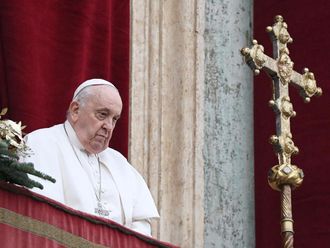London:
As a child, I loved Charlie Chaplin films. I would put on my father’s shoes and wander about with a trampish gait. Luckily, I never boiled and ate the shoes — I would not see Chaplin do that (in The Gold Rush) for a few years yet. I am of the last generation that found it quite normal to watch silent films on television.
There was nothing arcane or archaic about it. It was an everyday part of BBC2 programming. As I grew older, my love of Laurel and Hardy remained, but Chaplin went out of favour.
The received wisdom that he was overly sentimental meant that it became unfashionable to like him. Keaton was the one to revere; he was considered a more serious clown, with a stone face of existential angst and boasting a collaboration with Samuel Beckett.
Why it might be necessary to make a choice between Keaton and Chaplin I have no idea — there is time enough to celebrate both. But I find a surprising number of people who say: “I never really got Chaplin.”
Each time I return to Chaplin, I find it harder to understand how anyone can dismiss him. He wrote, produced, directed, starred in and composed the music for a series of powerful, funny, philosophical and moving films.
Even the first cinematic outing of the Tramp, Kid Auto Races at Venice (1914), can make me laugh 100 years on, as Chaplin repeatedly gets in the way of the news cameras and racing cars with such brazen cheek. Or there is the ludicrous image of Chaplin becoming a wooden hedgehog as he hurls 11 chairs on his back in Behind the Screen (1916), as fresh as any visual comedy being made now.
Though the bread-roll dance from The Gold Rush (1925) has been so often imitated that it may seem to have lost some of its wonder, watch the sequence again and you will see how intricate something of seeming simplicity is. Johnny Depp spoke of having to imitate it in Benny and Joon and said it took days to get everything just right.
That is what makes Chaplin live on — the depth of thought behind each routine. It is never just falling over with a bang, it is acrobatics with aplomb, it is the grace of the chaos. As one biographer, Richard Schickel, noted, with Chaplin all that seems solid melts into something else.
To those who ask “but is Chaplin really still funny?”, I can promise that a new generation of children do laugh at Chaplin attempting a tightrope walk while distracted by monkeys in The Circus (1928).
The Rink (1916) is my earliest memory of watching Chaplin. Here he is, a waiter, his face showing no servile deference as he works out a bill based on the remnants of food spattered over a diner ( Eric Campbell), before pocketing an unoffered tip.
He is lovable, rebellious, coquettish, both worldly and otherworldly. As for the roller-rink routine in that film, I would watch Dancing on Ice if only it were that good. Eric Campbell was also the monstrous street-fighting adversary in Easy Street (1917). Unable to floor him, or even move him with fisticuffs, Chaplin eventually overcomes him by pulling his head into the lamp of a street light and gassing him.
Woody Allen declared that Easy Street would be funny a thousand years from now. The potency of the ridiculousness has made it last nearly a century already. Neil Brand, a fine pianist who frequently accompanies silent film performances, acknowledges that today’s audiences have to overcome the mores and attitudes of a bygone age but says that, once that is done, we can still empathise with Chaplin as he responds to overwhelming forces.
City Lights (1931), Chaplin’s most revered film and highest on the American Film Institute’s 100 greatest films list, opens on a scene of accidental rebellion. The grand unveiling of an epic statue is ruined when the drape comes off to reveal the Tramp asleep in the arms of the granite god. As the US national anthem plays, the Tramp attempts to stand to attention while dangling by the butt of his trousers from the sword of a carved figure.
There is set piece after set piece and, though my twentysomething self sneered at the innocent love story of Tramp and blind girl, the fortysomething me is more romantic and easily moved by this tale of a tramp who will do anything for the love of a woman. It also has the best joke with an elephant in any movie I can think of. As for The Great Dictator (1940), amid the drama, social commentary and vivid portrayal of the rising oppression of the Jewish people in Germany, there are moments of superb broad comedy. If that doesn’t work for you, watch him dressed as a chicken in Gold Rush.
There is beauty, humour and humanity to be found here, Chaplin was, and is, a cinematic clown genius.
Peter Ackroyd’s biography Charlie Chaplin is published this week by Chatto & Windus
— The Telegraph Group Limited, London 2014












